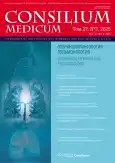Features of the clinical picture and quality of life in patients with idiopathic pulmonary fibrosis and hypersensitivity pneumonitis
- Authors: Suvorova O.A.1, Trushenko N.V.1,2, Lavginova B.B.1, Levina I.A.1, Merzhoeva Z.M.1, Avdeev S.N.1,2
-
Affiliations:
- Sechenov First Moscow State Medical University (Sechenov University)
- Research Institute of Pulmonology
- Issue: Vol 27, No 3 (2025): Otorhinolaryngology and pulmonology
- Pages: 179-186
- Section: Articles
- URL: https://bakhtiniada.ru/2075-1753/article/view/309759
- DOI: https://doi.org/10.26442/20751753.2025.3.203265
- ID: 309759
Cite item
Full Text
Abstract
Background. Idiopathic pulmonary fibrosis (IPF) and hypersensitivity pneumonitis (HP) are interstitial lung diseases with similar symptoms: dyspnea and cough, which determine disease severity and serve as prognostic markers.
Aim. To compare clinical and functional characteristics and their dynamics in patients with IPF and different HP phenotypes, and to assess the relationship between symptoms and objective test results.
Materials and methods. A longitudinal observational study included 153 patients (48 with IPF, 105 with HP, including 72 fibrotic HP [fHP], of whom 32 had a UIP pattern). Demographic, anamnestic, and functional parameters (spirometry, body plethysmography, DLco) were analyzed. Dyspnea (mMRC scale), cough (VAS and LCQ questionnaire), 6MWT results, HRCT changes, and echocardiographic signs of right heart dysfunction were assessed at baseline and after 12 months. Statistical analysis included nonparametric tests, Spearman correlation, and multiple linear regression to evaluate the impact of parameters on dyspnea and cough.
Results. Patients with fHP and fHP+UIP did not significantly differ from IPF patients in dyspnea severity (mMRC), cough intensity (VAS), or functional parameters. Mortality and disease progression were comparable between IPF, fHP, and fHP+UIP groups. Dyspnea severity correlated with GAP scores, 6MWT distance, SpO2 at baseline and end of 6MWT, presence of fibrosis on HRCT, functional parameters (DLco, CPI, etc.), and Charlson Comorbidity Index. Regression analysis showed that end-exercise SpO2 and pulmonary fibrosis had the greatest impact on dyspnea. Cough correlated with fibrosis, dyspnea (mMRC), and functional parameters (FVC, FEV1, CPI). FEV1 and pulmonary fibrosis were the most significant predictors of cough severity.
Conclusion. Patients with fHP, particularly those with a UIP pattern, have comparable functional impairment and clinical manifestations to IPF patients. Dyspnea and cough are closely associated with exertional desaturation, functional parameters, and pulmonary fibrosis on HRCT, which should be considered when evaluating HP and IPF.
Full Text
##article.viewOnOriginalSite##About the authors
Olga A. Suvorova
Sechenov First Moscow State Medical University (Sechenov University)
Author for correspondence.
Email: olga.a.suvorova@mail.ru
ORCID iD: 0000-0001-9661-7213
Assistant
Russian Federation, MoscowNatalia V. Trushenko
Sechenov First Moscow State Medical University (Sechenov University); Research Institute of Pulmonology
Email: olga.a.suvorova@mail.ru
ORCID iD: 0000-0002-0685-4133
Cand. Sci. (Med.)
Russian Federation, Moscow; MoscowBaina B. Lavginova
Sechenov First Moscow State Medical University (Sechenov University)
Email: olga.a.suvorova@mail.ru
ORCID iD: 0000-0003-1254-6863
Medical Resident
Russian Federation, MoscowIuliia A. Levina
Sechenov First Moscow State Medical University (Sechenov University)
Email: olga.a.suvorova@mail.ru
ORCID iD: 0000-0002-0928-2900
Medical Resident
Russian Federation, MoscowZamira M. Merzhoeva
Sechenov First Moscow State Medical University (Sechenov University)
Email: olga.a.suvorova@mail.ru
ORCID iD: 0000-0002-3174-5000
Cand. Sci. (Med.)
Russian Federation, MoscowSergey N. Avdeev
Sechenov First Moscow State Medical University (Sechenov University); Research Institute of Pulmonology
Email: olga.a.suvorova@mail.ru
ORCID iD: 0000-0002-5999-2150
D. Sci. (Med.), Prof.
Russian Federation, Moscow; MoscowReferences








